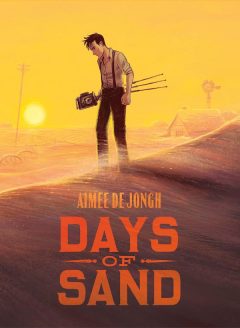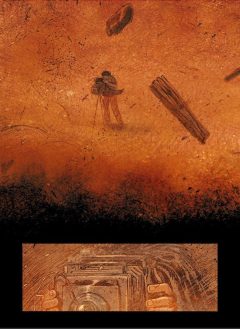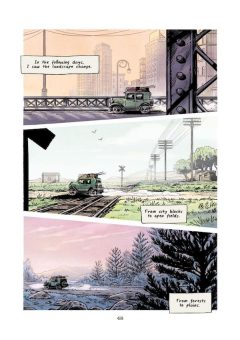Review: Days of Sand (SelfMadeHero)
Set in 1930’s USA during The Great Depression, photographer John Clark is tasked with documenting the Dust Bowl; a period of severe dust storms that damage ecology and agriculture. But how much can photographs help the plight of the people when it comes to deadly dust storms wreaking havoc? Find out in Aimée de Jongh’s new graphic novel, Days of Sand!
 Publisher: SelfMadeHero
Publisher: SelfMadeHero
Writer: Aimée de Jongh
Artist: Aimée de Jongh
Price: Buy for £16.99 from SelfMadeHero’s website
Days of Sand immediately fills its reader with a sense of abandonment. Its first pages are full of empty, dismal landscapes, merely occupied by dust. Crops are dying, buildings are broken and there are no people to be seen. These initial wordless pages evoke a tone of loss and ruin which is intricately woven throughout the rest of this moving graphic novel.
In Oklahoma, 1937, we are introduced to our central protagonist John Clark, burying what we assume is a body in the empty, dusty countryside. This is a man full of regret. How did he get here? He’s about to tell us; the panels transform from dusty lilac hues to bright primary colours, as we retrospectively enter the city of Washington where our story begins.
We soon discover that John is attending a job interview and that, in hindsight, he sees this as the catalyst for the chaos that will apparently follow. John is a photographer, and is tasked with taking pictures of farmers who are suffering after an economic crash. After a successful interview, he is packed off to No Man’s Land (ominous much?) for the month, to investigate ‘the dust bowl’, otherwise known as the ‘American Sahara’, where dust clouds wreak devastation on people’s health, crops, and land. Leaving the pink morning haze behind him, John eagerly sets out to No Man’s Land, as the America he knows fades behind him – this is a trip that will change him forever.
 A subtle transformation from thriving, healthy green into empty, endless yellow takes place as John enters Oklahoma, where ‘all green disappear[s]’’. As John comments, it’s clear that ‘death ha[s] come to this place’. He isn’t exaggerating. The accompanying illustrations make clear the complete devastation caused by the dust storms, showing animal skulls, buildings that have fallen in on themselves, and sand sand sand, as far as the eye can see, that even obscures the sun.
A subtle transformation from thriving, healthy green into empty, endless yellow takes place as John enters Oklahoma, where ‘all green disappear[s]’’. As John comments, it’s clear that ‘death ha[s] come to this place’. He isn’t exaggerating. The accompanying illustrations make clear the complete devastation caused by the dust storms, showing animal skulls, buildings that have fallen in on themselves, and sand sand sand, as far as the eye can see, that even obscures the sun.
Taking in the illustrations of the people living in Oklahoma felt a little like reliving the strangeness of seeing people wearing masks during the pandemic for the first time. But times a million. These people aren’t just wearing masks, they’re donning goggles, gas masks, helmets, anything that will keep the dust out. The attitude of keeping things out seems to transpire to unknown people also, as John has a tough time convincing anyone to let him take his pictures, something he finds increasingly frustrating.
We don’t have to wait too long before we see a dust storm in the flesh – and Aimée de Jongh’s visualization of this is truly fantastic; a hurricane of oranges, blacks and yellows seemingly swallow John whole as random debris circles and hounds him as if he’s prey. We particularly enjoyed the way Jongh presented the wind – it almost looks etched or scratched onto the page as it swoops, swirls, and contorts around John as the burning sun watches the dust overcome.
 Pretty soon, John is interacting with the locals and learning more about the negative impact the dust has made, including poverty, sickness, and even death. This slowly starts to take its toll on John, who begins to experience traumatic flashbacks about his abusive father. As he gets to know the locals, develops friendships and even potential relationships, and sees the effects that the dust storms are having, John becomes more and more disillusioned with taking photographs. What is the real purpose of them? Are they actively helping these people in need?
Pretty soon, John is interacting with the locals and learning more about the negative impact the dust has made, including poverty, sickness, and even death. This slowly starts to take its toll on John, who begins to experience traumatic flashbacks about his abusive father. As he gets to know the locals, develops friendships and even potential relationships, and sees the effects that the dust storms are having, John becomes more and more disillusioned with taking photographs. What is the real purpose of them? Are they actively helping these people in need?
Aimée de Jongh is stunningly creative in her use of colour. This is especially transparent in the scenes in which John is in a different place entirely, whether this is physically or mentally. The atmosphere completely shifts, from the quiet pink hues of an early morning in the city to the bright vibrant blue of the sky in an open field, to a calming mix of purple and green in an evening drive through a forest.
There are fantastic details included throughout, reminding readers that this story isn’t purely fiction; the Dust Bowl really happened and was a terrifying experience for many. Details like the map at the beginning showing the scope of the dust bowl, photographs of the insane dust clouds, quotes from real-life witnesses, and the pictures of survivors for every new chapter demonstrate the real-life devastation. In short, Days of Sand fantastically reflects the desolation of the Dust Bowl and the consequences for real people. This moving graphic novel needs a place on every reader’s bookshelf.



October 9, 2025 @ 3:55 am
I appreciate the effort put into this post. Watch star sports channels — IPL and international cricket with commentary, highlights, match previews, and post‑match analysis. Smooth HD streams on mobile, tablet, and TV.
October 13, 2025 @ 9:13 pm
**mind vault**
mind vault is a premium cognitive support formula created for adults 45+. It’s thoughtfully designed to help maintain clear thinking
October 21, 2025 @ 5:51 am
**prostadine**
prostadine is a next-generation prostate support formula designed to help maintain, restore, and enhance optimal male prostate performance.
October 22, 2025 @ 3:41 am
**sugarmute**
sugarmute is a science-guided nutritional supplement created to help maintain balanced blood sugar while supporting steady energy and mental clarity.
October 22, 2025 @ 4:16 pm
**glpro**
glpro is a natural dietary supplement designed to promote balanced blood sugar levels and curb sugar cravings.
October 23, 2025 @ 4:43 am
**zencortex**
zencortex contains only the natural ingredients that are effective in supporting incredible hearing naturally.
October 23, 2025 @ 4:44 am
**mitolyn**
mitolyn a nature-inspired supplement crafted to elevate metabolic activity and support sustainable weight management.
October 23, 2025 @ 6:17 am
**prodentim**
prodentim an advanced probiotic formulation designed to support exceptional oral hygiene while fortifying teeth and gums.
October 23, 2025 @ 6:43 am
**vittaburn**
vittaburn is a liquid dietary supplement formulated to support healthy weight reduction by increasing metabolic rate, reducing hunger, and promoting fat loss.
October 23, 2025 @ 6:44 am
**yusleep**
yusleep is a gentle, nano-enhanced nightly blend designed to help you drift off quickly, stay asleep longer, and wake feeling clear.
October 23, 2025 @ 7:15 am
**synaptigen**
synaptigen is a next-generation brain support supplement that blends natural nootropics, adaptogens
October 23, 2025 @ 8:14 am
**nitric boost**
nitric boost is a dietary formula crafted to enhance vitality and promote overall well-being.
October 23, 2025 @ 9:01 am
**glucore**
glucore is a nutritional supplement that is given to patients daily to assist in maintaining healthy blood sugar and metabolic rates.
October 23, 2025 @ 9:12 am
**wildgut**
wildgutis a precision-crafted nutritional blend designed to nurture your dog’s digestive tract.
October 24, 2025 @ 6:36 am
**pinealxt**
pinealxt is a revolutionary supplement that promotes proper pineal gland function and energy levels to support healthy body function.
October 24, 2025 @ 7:04 am
**energeia**
energeia is the first and only recipe that targets the root cause of stubborn belly fat and Deadly visceral fat.
December 2, 2025 @ 8:03 am
playboy casino
References:
http://47.97.159.144:3000/florapacker92
October 24, 2025 @ 7:50 am
**boostaro**
boostaro is a specially crafted dietary supplement for men who want to elevate their overall health and vitality.
October 24, 2025 @ 8:13 am
**prostabliss**
prostabliss is a carefully developed dietary formula aimed at nurturing prostate vitality and improving urinary comfort.
October 24, 2025 @ 11:45 am
**breathe**
breathe is a plant-powered tincture crafted to promote lung performance and enhance your breathing quality.
October 24, 2025 @ 4:52 pm
**potent stream**
potent stream is engineered to promote prostate well-being by counteracting the residue that can build up from hard-water minerals within the urinary tract.
October 25, 2025 @ 3:17 am
**hepato burn**
hepato burn is a premium nutritional formula designed to enhance liver function, boost metabolism, and support natural fat breakdown.
October 25, 2025 @ 8:26 am
**hepato burn**
hepato burn is a potent, plant-based formula created to promote optimal liver performance and naturally stimulate fat-burning mechanisms.
October 25, 2025 @ 4:16 pm
**cellufend**
cellufend is a natural supplement developed to support balanced blood sugar levels through a blend of botanical extracts and essential nutrients.
October 25, 2025 @ 5:00 pm
**prodentim**
prodentim is a forward-thinking oral wellness blend crafted to nurture and maintain a balanced mouth microbiome.
October 25, 2025 @ 6:46 pm
**flowforce max**
flowforce max delivers a forward-thinking, plant-focused way to support prostate health—while also helping maintain everyday energy, libido, and overall vitality.
October 25, 2025 @ 7:25 pm
**revitag**
revitag is a daily skin-support formula created to promote a healthy complexion and visibly diminish the appearance of skin tags.
October 25, 2025 @ 7:26 pm
**neurogenica**
neurogenica is a dietary supplement formulated to support nerve health and ease discomfort associated with neuropathy.
October 26, 2025 @ 4:22 pm
**sleeplean**
sleeplean is a US-trusted, naturally focused nighttime support formula that helps your body burn fat while you rest.
October 27, 2025 @ 11:52 pm
**memorylift**
memorylift is an innovative dietary formula designed to naturally nurture brain wellness and sharpen cognitive performance.
December 6, 2025 @ 7:49 pm
As a seasoned player, understanding baccarat odds can truly elevate your game. Platforms like Jili77 offer intuitive tools and AI insights that make strategy-building more dynamic and rewarding.
December 16, 2025 @ 8:12 am
Just a smiling visitor here to share the love (:, btw great design and style.
December 20, 2025 @ 1:46 am
I went over this internet site and I think you have a lot of good info, saved to fav (:.
December 23, 2025 @ 4:21 am
Dice games are surprisingly mathematical! Thinking about probability & RNG, it’s cool how platforms like 333jili register games prioritize fairness & security with audits – essential for a good experience, right? Fun stuff!